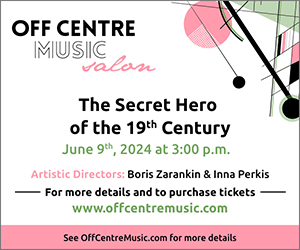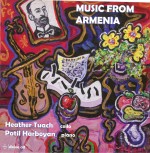 The idea for Music from Armenia for Cello and Piano, a Divine Art CD (divineartrecords.com) featuring Newfoundland cellist Heather Tuach and the Armenian-Canadian pianist Patil Harboyan, began with a 2012 recital by the duo in Newfoundland that included Alexander Arutiunian’s Impromptu, the short work that opens this disc. The enthusiastic audience reaction to the piece encouraged the performers to search the Armenian cello and piano repertoire for music that would make for an appealing and informative CD. They certainly succeeded.
The idea for Music from Armenia for Cello and Piano, a Divine Art CD (divineartrecords.com) featuring Newfoundland cellist Heather Tuach and the Armenian-Canadian pianist Patil Harboyan, began with a 2012 recital by the duo in Newfoundland that included Alexander Arutiunian’s Impromptu, the short work that opens this disc. The enthusiastic audience reaction to the piece encouraged the performers to search the Armenian cello and piano repertoire for music that would make for an appealing and informative CD. They certainly succeeded.
Armenia was under Soviet Russian rule from 1920 to 1991, and the music here is essentially what you would expect from that background (Arno Babajanian’s Vocalise, for example, is very similar to Rachmaninov’s), but the significant aspect of the CD is its recognition of the importance of the documentation and preservation of Armenian folk music.
The crucial figure in this respect was Gomidas, described in the excellent booklet notes as the founder of Armenian classical music and ethnomusicology, working in much the same manner as his direct contemporary Béla Bartók in Hungary. Most of his ten short folk songs here are arrangements by cellist Geronty Talalyan of the string quartet versions by Sergei Aslamazian, and they’re highly entertaining.
The one major work on the CD is the Sonata for Cello and Piano Op.35 by Haro Stepanian, who graduated from the Leningrad Conservatory and also collected Armenian melodies from his homeland; the influences of both his Russian training and his Armenian folk music research are evident in a very attractive and effective work.
The whole CD is a fascinating portrait of a musical heritage perhaps most widely represented for most people by the music of Aram Khachaturian, who openly acknowledged his – and Armenian music’s – debt to Gomidas. The performances are rich and full of nuance, and the balance and recorded sound are ideal.
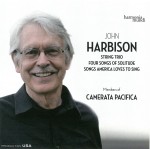 Chamber Works is a quite exceptional new CD featuring members of Camerata Pacifica playing music by the American composer John Harbison, who turns 76 later this month (harmonia mundi usa HMU 907619). Violinist Amy Schwartz Moretti, violist Richard O’Neill and cellist Ani Aznavoorian combine for the six-movement String Trio from 2013, a striking work of strength and depth.
Chamber Works is a quite exceptional new CD featuring members of Camerata Pacifica playing music by the American composer John Harbison, who turns 76 later this month (harmonia mundi usa HMU 907619). Violinist Amy Schwartz Moretti, violist Richard O’Neill and cellist Ani Aznavoorian combine for the six-movement String Trio from 2013, a striking work of strength and depth.
Paul Huang is outstanding in the Four Songs of Solitude for solo violin, written for Harbison’s violinist wife. Technically challenging, these are lyrical pieces (“songs, not sonatas or fugues,” stresses the composer) with a definite edge.
Songs America Loves to Sing, a set of ten popular American melodies for flute, clarinet, violin, cello and piano, rounds out a marvelous CD. The final track, Anniversary Song, ends with a wheezy harmonica contribution in Happy Birthday To You. It’s simply terrific stuff!
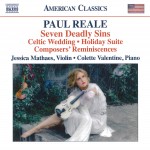 One of the real benefits of reviewing CDs is the exposure to composers – especially contemporary ones – who are new to you. Seven Deadly Sins, the new Naxos American Classics CD (9.70204) of music for violin and piano by Paul Reale, who turned 71 this year, leaves me wondering why I haven’t encountered his music before. I’ve obviously been missing something. The terrific Jessica Mathaes (another name new to me) is the violinist here on her second CD, and Colette Valentine the equally impressive pianist.
One of the real benefits of reviewing CDs is the exposure to composers – especially contemporary ones – who are new to you. Seven Deadly Sins, the new Naxos American Classics CD (9.70204) of music for violin and piano by Paul Reale, who turned 71 this year, leaves me wondering why I haven’t encountered his music before. I’ve obviously been missing something. The terrific Jessica Mathaes (another name new to me) is the violinist here on her second CD, and Colette Valentine the equally impressive pianist.
The Seven Deadly Sins suite was written in 2009 for Mathaes especially for this recording (made in 2012) and offers humorous observations of their effect on the human condition. Composers’ Reminiscences is a suite for solo violin written in 2000, but substantially revised for this recording. The seven short but challenging pieces are described as “impressions” (and not imitations) of the styles of Bartók, Puccini, Paganini, Webern, Corelli, Ives and Haydn, but to be honest it’s difficult to differentiate between the two approaches. The Sonata for Violin and Piano, “Celtic Wedding” is another work that has been extensively revised, this time from the 1991 original, for its publication in 2007.
The CD ends with the all-too-brief Holiday Suite, three very short pieces celebrating Thanksgiving, Christmas and New Year’s; the latter features Auld Lang Syne mixed with the soul of Dave Brubeck’s Take Five. “This is good-time music,” says Reale, “melody driven, and devoid of pretension.”
That’s also a pretty good description of the entire CD. This is immediately accessible music written with craft, bite, intelligence and humour, and given outstanding performances. Surprisingly, only the Celtic Wedding is available in sheet music form. It’s a pity; this is music that cries out for – and would be greatly appreciated by – a much wider audience.
There was a time, after the 1964 Isaac Stern and Leonard Bernstein Columbia LP was deleted from the catalogue, when you would have been hard pushed to find a recording of Samuel Barber’s Violin Concerto, but things have certainly changed: it’s now probably the most popular violin concerto of the 20th century, and is currently available on at least two dozen CDs.
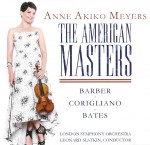 The American violinist Anne Akiko Meyers opens her latest CD, The American Masters (eOne EOM-CD-7791), with her second recorded performance of the Barber; the concerto was featured on her debut CD in 1988. It’s really difficult to find an unsatisfactory performance of this work, and there’s certainly no danger of that here. I haven’t been able to compare this recording with the 1988 performance, but I suspect that this one is perhaps more introspective and nuanced, reflecting the quarter of a century that Meyers has spent with the work. It may be somewhat less passionate and intense than some recordings, especially in the haunting slow movement, but it’s an intelligent and committed performance.
The American violinist Anne Akiko Meyers opens her latest CD, The American Masters (eOne EOM-CD-7791), with her second recorded performance of the Barber; the concerto was featured on her debut CD in 1988. It’s really difficult to find an unsatisfactory performance of this work, and there’s certainly no danger of that here. I haven’t been able to compare this recording with the 1988 performance, but I suspect that this one is perhaps more introspective and nuanced, reflecting the quarter of a century that Meyers has spent with the work. It may be somewhat less passionate and intense than some recordings, especially in the haunting slow movement, but it’s an intelligent and committed performance.
There is clearly intelligence in the programming of this CD, too, with John Corigliano’s Lullaby for Natalie, a short piece written for Meyers in 2010 and named for her baby daughter, forming the central point between the Barber concerto and the Violin Concerto by Mason Bates, a work commissioned by Meyers. Corigliano was mentored by Barber in a relationship that developed into a close friendship, and Bates has enjoyed an identical relationship with Corigliano.
The Bates concerto, written in 2012, is an interesting work that promises to become more effective on closer acquaintance. The soloist, in the composer’s own words, is treated as a hybrid musical creature, based on the Archaeopteryx, the first dinosaur/bird hybrid; the three movement titles – Archaeopteryx, Lakebed memories and The rise of the birds – reflect the continuous unfolding of the music.
Leonard Slatkin conducts the London Symphony Orchestra, and is clearly in his element with the music: Corigliano notes that as well as being a close friend of his, Slatkin has also championed all three composers on the disc. Meyers, incidentally, is now playing the 1741 ex-Vieuxtemps Guarneri del Gesu violin, bought by an anonymous buyer in 2013 and awarded to Meyers for her lifetime use; the price was reported as being in excess of 16 million dollars. Needless to say, the sound throughout the CD is sumptuous!
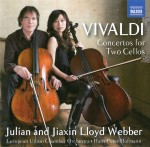 Cellist Julian Lloyd Webber is joined by his cellist wife Jiaxin Lloyd Webber and the European Union Chamber Orchestra directed by violinist Hans-Peter Hofmann in a CD of Vivaldi Concertos for Two Cellos (Naxos 8.573374). Only one of the six concertos here – the G minor, RV531 – is a Vivaldi two-cello original, the others being arrangements by Lloyd Webber of concertos for two mandolins (in G major, RV532), cello and bassoon (in E minor, RV409), oboe and bassoon (in G major, RV545), two horns (in F major, RV539) and the recently discovered Concerto in G minor, RV812 for violin and cello.
Cellist Julian Lloyd Webber is joined by his cellist wife Jiaxin Lloyd Webber and the European Union Chamber Orchestra directed by violinist Hans-Peter Hofmann in a CD of Vivaldi Concertos for Two Cellos (Naxos 8.573374). Only one of the six concertos here – the G minor, RV531 – is a Vivaldi two-cello original, the others being arrangements by Lloyd Webber of concertos for two mandolins (in G major, RV532), cello and bassoon (in E minor, RV409), oboe and bassoon (in G major, RV545), two horns (in F major, RV539) and the recently discovered Concerto in G minor, RV812 for violin and cello.
It was, of course, normal practice in the time of Bach and Vivaldi for composers to transcribe their own works for different instruments, so there’s nothing radical happening here. These three-movement concertos are all very short, however (only three exceed ten minutes, and none reaches the 12-minute mark), and while there are variations in the content it does tend to bring to mind the old line about Vivaldi having written not 500 different concertos, but the same concerto 500 times.
Most of the time it does tend to sound as if there is only one solo cello, or perhaps more accurately a solo cello with a cello continuo underneath, but there’s a light-hearted feel to the performances and the recordings, and excellent playing by all concerned. It sounds like it must have been great fun to do; it’s certainly great fun to listen to.
The final track on the CD, somewhat puzzlingly, is Lloyd Webber’s attractive arrangement for two cellos of the Milonga from Astor Piazzolla’s Concerto for Bandoneon and Guitar. The two cellos are clearly independent and intertwining voices here. All works other than the Vivaldi original concerto are world premiere recordings of these arrangements.
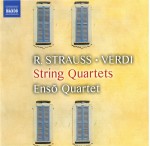 Formed at Yale University and based in New York City since 2007, the Ensō String Quartet has been active for 15 years now, and has built a formidable reputation in the process including winning the Banff International String Quartet Competition in 2004. String Quartets, their seventh album – and fifth for Naxos – features the complete string quartet music by three composers known primarily for their operas: Richard Strauss, Giuseppe Verdi and Giacomo Puccini (Naxos 8.573108).
Formed at Yale University and based in New York City since 2007, the Ensō String Quartet has been active for 15 years now, and has built a formidable reputation in the process including winning the Banff International String Quartet Competition in 2004. String Quartets, their seventh album – and fifth for Naxos – features the complete string quartet music by three composers known primarily for their operas: Richard Strauss, Giuseppe Verdi and Giacomo Puccini (Naxos 8.573108).
From the opening bars of the early Strauss String Quartet in A Major, written when the composer was 17, it is clear why the ensemble has been garnering rave reviews for their CD releases; it’s beautifully rich, full-blooded and warm playing from the outset, and just perfect for the late Romantic nature of the music. Puccini’s Crisantemi, reportedly written in a single evening in 1890 in memory of the composer’s friend the Duke of Aosta, is a short piece named for chrysanthemums, the Italian flower of mourning, and is well known in both its original form and in a string orchestra setting. Rarely heard, however, are his charming Three Minuets in A Major, written when the composer was 25.
Most people, when they find they have some unexpected free time on their hands, just relax; the 60-year-old Verdi, when the Naples premiere of his opera Aida in 1873 had to be postponed for a few days due to the lead soprano’s illness, chose to sit down and write a string quartet. The String Quartet in E Minor is his only work in the genre, and attempted to marry the Italian vocal tradition with the German classical quartet form. Critical opinion differed on its success, but it’s a solid and finely crafted work, perhaps less purely melodic than you would expect, and with a strong formal structure. It can tend to sound somewhat ponderous and serious in the wrong hands, but the performance here strikes exactly the right balance.
The recording was made in the glorious acoustics of St. Anne’s Anglican Church in Toronto, with the ever-reliable team of Norbert Kraft and Bonnie Silver in charge. The quality of the recorded sound, not surprisingly, is superb.
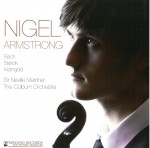 I was somewhat nonplussed by Nigel Armstrong, the eponymous debut CD by the young American violinist on Yarlung Records, a label which specialises in producing debut discs by rising young artists (Yarlung Records 65007). Two unaccompanied works, the Bartók Sonata for Solo Violin and the Bach Sonata No.3 in C Major are both given accomplished performances, but Armstrong’s vibrato seems a bit narrow and thin, giving the recordings a slightly strained air at times. He’s up against major competition in such works, of course, and while there is much to admire here – especially the smooth melodic line in the contrapuntal Bach sections – neither performance is likely to unseat whichever favourite you have in your collection.
I was somewhat nonplussed by Nigel Armstrong, the eponymous debut CD by the young American violinist on Yarlung Records, a label which specialises in producing debut discs by rising young artists (Yarlung Records 65007). Two unaccompanied works, the Bartók Sonata for Solo Violin and the Bach Sonata No.3 in C Major are both given accomplished performances, but Armstrong’s vibrato seems a bit narrow and thin, giving the recordings a slightly strained air at times. He’s up against major competition in such works, of course, and while there is much to admire here – especially the smooth melodic line in the contrapuntal Bach sections – neither performance is likely to unseat whichever favourite you have in your collection.
Then comes a live performance of the Korngold Violin Concerto, recorded with the Colburn Orchestra (Armstrong spent four years at the Colburn School in Los Angeles) under Sir Neville Marriner, and we’re in a different world. The vibrato is bigger and warmer, the tone rich and full, and the soaring, expansive performance quite outstanding, although again Armstrong is up against stiff competition in the market. If there’s one aspect that’s a bit disappointing, it’s the recording quality: there is a fair bit of audience and extraneous noise, and the acoustics in the concert hall seem very dry. The movement tracks are also cut off very quickly to exclude any audience reaction.
I did what I normally do with performers who are new to me, and looked Armstrong up online; I was astonished at what I found. There’s a brief but interesting clip on YouTube in which Bob Attiyeh, the producer of the CD, explains how they went about it (look for Nigel Armstrong The Debut Recording) but the real gems were the associated links. There are clips from Armstrong’s performances at a violin competition in Buenos Aires in 2010, one a gorgeous Piazzolla work with string bass and bandoneon and the other a terrific Paganini Caprice, and two clips from the Tchaikovsky Competition in Moscow, one of the end section of the Bach D minor Chaconne, and the other a simply astonishing performance of John Corigliano’s Stomp for solo violin, a fiddle-based work that includes Armstrong playing the instrument behind his back.
The CD booklet notes spend a fair amount of time in a navel-gazing discussion of the choices and challenges facing an international concert soloist – Armstrong spent some time studying at a Zen monastery in upstate New York, and has spent summers working on an organic farm in Germany. Attiyeh says that he looks forward to Armstrong’s next Los Angeles concert, “or to the taste of a new Armstrong organic carrot, whichever comes first.” I’m not sure that he’s joking.
It will certainly be interesting to see where this young man’s career leads him. One thing is clear: he’s an astonishing talent, and I’m not sure this debut CD really does him justice.



